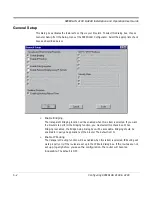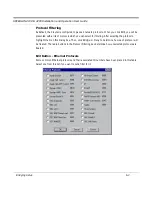
SPEEDLAN 4100 & 4200 Installation and Operation User Guide
Configuring SPEEDLAN 4100 & 4200
5-9
Advanced Button - 11 Mb RF Interface Setup
The Advanced button is located to the left of the Frequency button. Clicking this button will open a
new dialog box that allows you to change the Network ID and rate of the interface.
•
Network ID
The Network ID is a security setting that allows the brouter to reject packets from other
wireless brouters in the area. Although the bridging or routing table would reject the packet
once it was processed, the Network ID allows the brouter to reject the packet with less
processing. This improves the performance of the brouters in installations where many
wireless brouters are co-located in the same area or where other organizations may be
running wireless bridges of their own. The default setting is 0 and the valid range is 0 to 15.
This setting must be set to the same value for the brouters that will be communicating together.
Failure to set them to the same value will prevent any communications from taking place. For
example, in order to use a multipoint link, you must use the same Network ID setting on the base
station (SPEEDLAN 4100) and on the CPE brouter (SPEEDLAN 4200).
•
Rate
This setting refers to the RF data rate. The SPEEDLAN 11 Mbps radios have four data rates
that can be used:
•
High
This is the full 11 Mbps data rate. The interface default to this value and it is recom-
mended that you operate using it for most installations. The receiver sensitivity of the
radio with this setting is -82 dBm.
•
Medium
This setting limits the card to providing 5.5 Mbps of bandwidth. The receiver sensitivity
of the radio with this setting is -85 dBm.
Summary of Contents for SPEEDLAN 4100
Page 7: ...Chapter 1 Introduction...
Page 11: ...Chapter 2 Quick Start...
Page 21: ...Chapter 3 Hardware...
Page 25: ...Chapter 4 Overview of Configurator...
Page 31: ...Chapter 5 Configuring SPEEDLAN 4100 4200...
Page 43: ...Chapter 6 Bridging Setup...
Page 53: ...Chapter 7 Setting Up the IP Addresses IP Host Setup...
Page 67: ...Chapter 8 IP Router Setup...
Page 73: ...Chapter 9 SNMP Setup...
Page 77: ...Chapter 10 System Access Setup...
Page 79: ...Chapter 11 SNMP Monitoring...
Page 105: ...Chapter 12 Tables...
Page 115: ...Chapter 13 Analyzing Wireless Equipment...
Page 123: ...Glossary for Standard Data Communications...






























